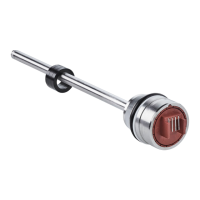6.8.2 SAE J1939
SAE J1939 features an extended message arbitration and a 29-bit extended message
identifier. This extension features a different message prioritization and assignment of
bus subscribers. For large quantities of data, it is possible to utilize a separate trans‐
port protocol. The communication objects for SAE J1939 are:
•
PDU (Protocol Data Unit):
There are two types of PDUs. PDU1 is used for peer-to-peer data transmission,
PDU2 is addressed to all bus subscribers.
•
PG (Parameter Groups):
PG refers to the grouping of process data and parameters for transmission in a
message. This parameter group data structure ensures efficient bus loading.
•
PGN (Parameter Group Number):
The PGN is a unique and standardized identifier of the parameter group.
•
SPN (Suspect Parameter Number):
The SPN uniquely identifies a parameter signal and is prescribed by the protocol.
This ensures that every SAE J1939 compatible device knows the parameter struc‐
ture.
•
TP (Transport Protocol):
TP is used for separate data transmission above 8 bytes.
According to the SAE J1939 protocol, each message has the following structure:
Table 18: CAN bus data protocol with J1939 identifier
PDU
SOF Arbitration Identifier Control Data
Field
CRC ACK EOF
1 Priority 3 2 PDU
Format 8
PDU
Specific 8
Source 8 6 0..8 byt
es
15 1 1 1 7
6.9 Configuration and system startup
After electrical connection to the network, the device is ready for commissioning and
configuration. Before actual system startup, the communication parameters for opera‐
tion need to be set in the CAN bus. Only the basic procedure is described in these oper‐
ating instructions. Please refer to the accompanying programming instructions for
details of all the available commands for configuring the device.
6.9.1 Configuring CANopen
Setting the node parameters
To be able to operate the device in a CAN bus network, it is necessary to first configure
the network characteristics. The basic settings for integrating a bus subscriber are
made using LSS (Layer Setting Services). Every device (node) in the CAN network is
uniquely identified by its LSS address. This address is composed as follows:
Table 19: LSS address
CANopen
Vendor-ID 0x1000056
Product code as per product key
Revision number as per product key
Serial Number actual serial number of the CANopen encoder
COMMISSIONING 6
8022793/ZXZ4/2018-07-24 | SICK O P E R A T I N G I N S T R U C T I O N S | MAX
31
Subject to change without notice

